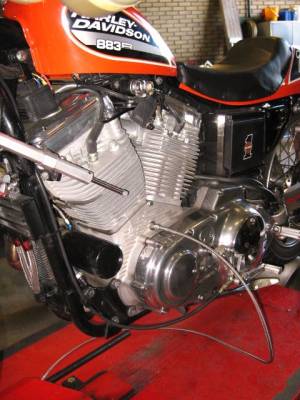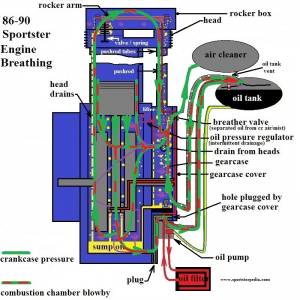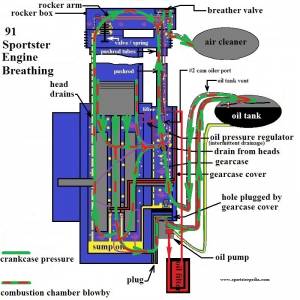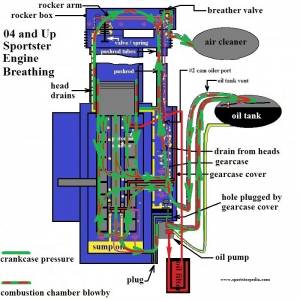Table of Contents
This is an old revision of the document!
REF: Engine Mechanicals
Evo Crankcase Pressure and Engine Breathing
Crankcase Pressure
Crankcase air pressure is mainly generated by the up and down movement of the pistons.
The downstroke of the piston causes the volume underneath the pistons to decrease which puts pressure on the oil in the sump. 1)
This pressure is multi use;
- It helps to push sump oil up and out the scavenge passage to the return side of the oil pump.
(the scavenge side of the pump also pulls a vacuum on the sealed passage from the sump outlet to the pump) 2) - It also initiates the splash and mist process as the compressed air above the oil is ready to spring up when the piston rises.
Then the upstroke of the piston creates an upward vacuum bringing some of the oil from the sump with it.
With little to no (piston ring) blow-by and a check valve on the breather system;
Crankcase pressure is essentially cycling between atmospheric and negative (pressures) as the pistons go down and back up.
(remember, due to the common crankpin 45 degree design, a Harley motor is a variable volume crankcase, unlike most motors) 3)
This creates splash oil which is bounced about in the crankcase.
This also creates an air / oil mix when tiny particles intertwine with the oil in suspension.
The two don't actually mix as does sugar and water.
So separating them back apart is fairly easy if you add an obstacle for that 'mix' to collide into.
The obstacle is widely known as the breather or umbrella valve although anything the mix touches in the motor could accomplish the same thing in theory.
The piston motions create a pulsating blast of air pressure (push pull condition as each piston rises and falls).
Static oil pump pressure has already been dissipated by the time it reaches the crankcase.
(although it takes static oil pressure to get the oil from the pump to the crankcase)
Likewise, crankcase (CC) pressure will have a constant change in velocity.
Oil in the crankcase adds resistance to the air pressure generated (raising the pressure).
The movement of the pistons and flywheels splash oil around in the engine.
Gravity oil (from the drain ports in the heads) returns to the crankcase or gearcase (respective to year model);
- On 86-03 engines, gravity oil falls into the crankcase sump area.
- On 04 and up engines, gravity oil falls into the gearcase.
Engine Breathing
The rockerbox (as well as cam chest) breather is connected to the oil tank breather. 4)
If you blow down the oil tank line…air comes out the rockerbox vents (or cam breather hose).
There are airways linking these compartments together and in looking at these airways.
If one pressurizes, they all pressurize and air can pass between them;
- Rocker Box:
- Pushrods connect the rockerbox to the gearcase.
- Gravity oil drains in the heads through drilled passages to the crankcase sump (03 and prior) or the gearcase (04 and up).
- Gearcase / cam chest:
- The rockerbox oil return connects to the gearcase.
- Airways thru the wall joins the sump and the scavenge side of pump.
- Piston downforce pumps air and oil from the sump to the gearcase compartment.
- This would equalise air pressures in the two chambers.
- Crankcase:
- Piston downstroke creates a positive pressure against the oil in the sump.
- This forward pressure is connected to the oil tank thru the oil pump.
- It also helps to push oil into the scavenge chamber from the sump upward into the scavenger side of the oil pump.
- Piston upstroke creates a negative pressure (noted as vacuum for this article).
- Some of the oil either draining to the sump or collected from the sump is picked up by the vacuum in the form of oil mist.
- Also some of the oil is picked up in the form of oil droplets (or splash oil) and is moved around by the next positive pressure condition.
Splash oil is further moved by the action of the flywheels, connecting rods, cam gears, air pressure and gravity.
- The pinion gear shaft is hollow and connects the crankcase to the gearcase (but would only pass air with the engine off).
| Testing CC pressure on the dyno. 9) |
 |
Revised crankcase breathing is an area where you have huge potential to create unintended consequences.
Few if any really understand the ifs, ands and buts of all the factors the factory took into consideration when they designed the system.
Gappless rings while great for ring seal are another area where you can get in over your head if you are not careful. 10)
Wet sumping is only one potential problem you may encounter with them. 11)
In the right application they can not be beat but you better have your ducks in a row.




